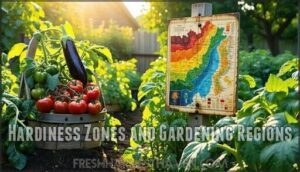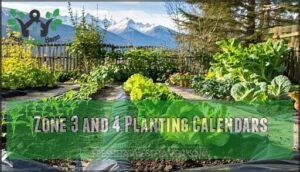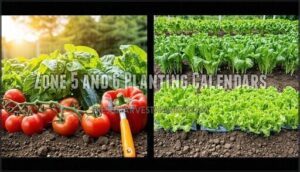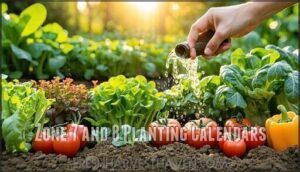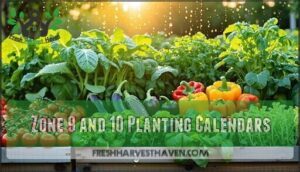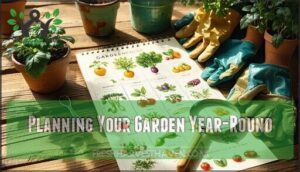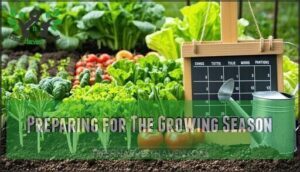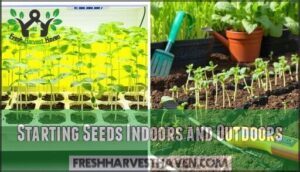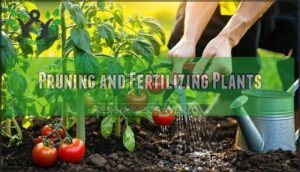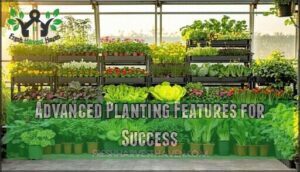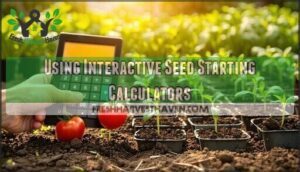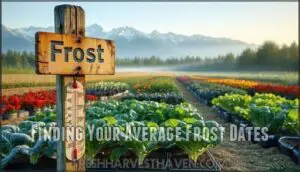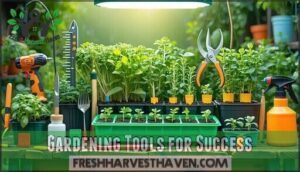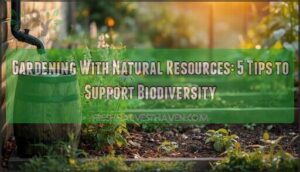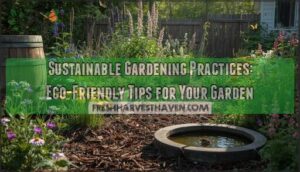This site is supported by our readers. We may earn a commission, at no cost to you, if you purchase through links.
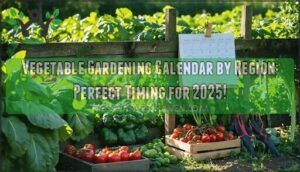
Each region faces unique growing challenges, from short northern summers to year-round southern growing seasons.
Understanding your hardiness zone helps you choose suitable varieties and time your plantings correctly.
Whether you’re in frigid Zone 3 or balmy Zone 10, regional calendars guarantee you’re working with nature’s rhythm, not against it.
These calendars factor in frost dates, soil temperature, and seasonal weather patterns to maximize your harvest success and minimize crop failures.
Table Of Contents
- Key Takeaways
- Regional Gardening Calendars Explained
- Hardiness Zones and Gardening Regions
- Planting Calendars by Region
- Planning Your Garden Year-Round
- Essential Gardening Tasks by Month
- Advanced Planting Features for Success
- Using Interactive Seed Starting Calculators
- Finding Your Average Frost Dates
- Gardening Tools for Success
- Maximizing Your Growing Season
- Frequently Asked Questions (FAQs)
- What is a vegetable planting calendar?
- What is a planting calendar?
- Where can I find a planting calendar?
- How do I create a localized planting calendar?
- When should you plant a vegetable garden?
- When should you plant vegetables in California?
- What vegetables to plant in what month?
- What vegetables can I grow in my region?
- Which vegetables should not be planted next to each other?
- Does the farmer’s almanac tell you when to plant?
- Conclusion
Key Takeaways
- You’ll prevent crop failures by matching your USDA hardiness zone to specific planting windows – knowing whether you’re in Zone 3 or Zone 10 determines which vegetables survive your winters and when to plant them safely.
- Your frost dates act as garden guardrails that protect tender plants from temperature disasters – calculating backward from your last spring frost and first fall frost creates precise planting schedules for each crop type.
- You can harvest fresh vegetables nearly year-round using succession planting and season extension techniques – staggering plantings every 1-2 weeks combined with cold frames and row covers maximizes your growing potential beyond traditional seasons.
- Your yard’s microclimates create unique growing opportunities that standard zone maps don’t reveal – sunny slopes, shaded areas, and elevation changes let you customize plant placement for better yields than following generic regional advice.
Regional Gardening Calendars Explained
Regional gardening calendars act like your garden’s GPS, guiding you to the perfect planting times for maximum harvests in your specific climate zone.
These calendars take the guesswork out of when to plant by matching your local frost dates with each crop’s growing needs.
Importance of Calendars for Gardening Success
Your vegetable gardening calendar transforms scattered planting attempts into strategic success.
Think of it as your garden’s GPS—no more guessing when to plant or wondering why crops failed.
These regional calendars nail down your area’s frost dates, growing season length, and ideal planting windows.
When you follow a structured planting schedule, you’ll avoid common mistakes like starting tomatoes too early or missing your fall lettuce window.
Timely planting becomes second nature as your calendar guides frost protection decisions and maximizes harvest yields through regional adaptation.
Smart planting strategies emerge naturally—you’ll know exactly when succession planting pays off and which varieties suit your climate.
Your gardening calendar isn’t just helpful advice; it’s the difference between disappointing harvests and abundant success that fills your table all season long.
How Calendars Help Choose Suitable Crops
Beyond simply marking dates on your calendar, regional planting schedules serve as your personal crop consultant, matching the right vegetables to your specific growing conditions.
These vegetable gardening calendar tools eliminate the frustration of failed harvests by guiding your plant selections based on proven regional success rates.
Here’s how calendar crop matching transforms your garden planning:
- Zone-specific varieties guarantee you’re planting cultivars bred for your climate’s unique challenges
- Optimal planting times maximize your harvest window while avoiding weather-related crop losses
- Microclimate considerations help you adapt recommendations to your yard’s specific conditions
Your regional gardening approach becomes strategic rather than hopeful.
Instead of wondering whether tomatoes will ripen before frost, your planting schedule provides clear harvest timing guidance.
This systematic method turns seasonal guesswork into reliable food production, connecting your planting times directly to successful regional vegetables that thrive in your area’s specific growing patterns.
Calendars and Climate Zones
Your vegetable gardening calendar by region works best when matched to your specific climate zone.
Zone Mapping through the USDA system (zones 3-10) provides the foundation for Calendar Customization.
Northern zones need earlier indoor starts and shorter seasons, while southern zones allow extended growing periods.
Regional Variations within zones create Microclimate Impact – your yard’s unique conditions matter.
Smart Planting Strategies adapt your gardening calendar to these local factors, ensuring your regional gardening success year after year.
Hardiness Zones and Gardening Regions
Understanding your hardiness zone is like having your garden’s GPS coordinates – it tells you exactly what plants will thrive in your specific climate conditions.
You’ll use this zone number to match vegetables with your local growing conditions and avoid costly planting mistakes that lead to failed harvests, which is crucial for a successful garden with thriving plants.
What Are Hardiness Zones?
Hardiness zones work like your garden’s GPS coordinates. The USDA created these USDA Zones by mapping Temperature Ranges across the country, with each zone representing average winter lows. Zone Maps divide the US into numbered sections from 3-10, helping you match plants to your local weather patterns.
Understanding your USDA hardiness zone prevents costly mistakes like planting tropical vegetables in Minnesota winters. Here’s what makes hardiness zones your best gardening tool:
- Temperature Ranges in each zone determine which plants survive winter in your area
- Zone Maps show geographic boundaries where specific vegetables thrive year-round
- Microclimates within zones create unique growing pockets around your property
- Plant Selection becomes simpler when you know your zone’s limits and possibilities
Your vegetable gardening calendar by region depends entirely on these gardening zones. To optimize your fall harvest, remember to check your zone’s frost dates for ideal planting times.
How to Find Your Hardiness Zone
Most gardeners discover their perfect growing zone through simple detective work. The USDA Zone Map serves as your garden’s GPS, instantly revealing your climate zone when you enter your zip code.
This official tool updates regularly to reflect changing weather patterns across regions.
Finding your zone requires multiple approaches for accuracy:
- Local nurseries offer firsthand knowledge of microclimate influence in your area
- Online tools provide detailed zone maps with recent updates and boundary changes
- Gardening apps include built-in zone finders with additional regional gardening features
- Elevation effects create mini-zones on your property that standard maps might miss
Your USDA hardiness zone forms the foundation for your vegetable gardening calendar by region, but remember that microclimates can shift these boundaries substantially within your own yard.
Planting Guidance by Hardiness Zone
With your USDA hardiness zone identified, you’re ready to create a winning vegetable gardening calendar by region.
Your zone acts as your garden’s roadmap, guiding planting decisions for maximum success.
Here’s how to use your hardiness zone effectively:
- Select zone-specific vegetables that match your regional climate patterns and temperature ranges
- Time planting windows around your area’s average frost dates for ideal growth cycles
- Make microclimate adjustments for unique yard conditions like elevation, wind exposure, or soil variations
Remember, your planting schedule serves as a flexible guide rather than rigid rules.
Regional variations within zones mean you’ll need to fine-tune timing based on local conditions and hardiness limitations for best results.
Planting Calendars by Region
Your hardiness zone determines when you can safely plant vegetables without frost damage.
Each zone has specific planting windows that maximize your growing season and guarantee healthy harvests throughout the year, which is a complete concept to consider for optimal gardening results.
Zone 3 and 4 Planting Calendars
Success in Zone 3 and Zone 4 requires strategic planning around harsh realities. These regions offer only 100-150 frost-free days, demanding careful selection of cold-hardy varieties and short-season crops.
You’ll need soil warming techniques like black plastic mulch to jumpstart spring planting when frost dates stretch into May. Knowing your plant hardiness zones is essential for successful garden planning.
Zone 3/4 microclimates can extend your growing season slightly. Focus on vegetable planting schedules that prioritize cool-season crops like lettuce, kale, and radishes. Your planting schedule must account for regional gardening challenges—frost protection methods become essential when late spring freezes threaten tender seedlings.
Zone 5 and 6 Planting Calendars
In Zones 5 and 6, your vegetable gardening calendar by region revolves around frost dates that shape your entire growing season. Zone 5 gardeners face their last spring frost around May 15, while Zone 6 enjoys an earlier May 1 date—giving you 30 extra frost-free days for regional gardening.
Your planting schedule should follow this zone planting timeline:
- Start cool-season crops like lettuce and spinach indoors by February 5
- Begin broccoli and cabbage seedlings indoors February 19 for April transplanting
- Prepare soil and set up frost protection systems in March
- Direct sow peas and kale outdoors by April 1
- Plant warm-season crops like tomatoes after your frost dates pass
- Implement pest management strategies as temperatures warm
Focus on soil preparation early—testing pH and adding compost before planting. For Zone 6, remember to wait at least two weeks past the last frost date before planting warm-season crops. This foundation guarantees your carefully timed zone planting efforts pay off with abundant harvests throughout your 150-180 day growing season.
Zone 7 and 8 Planting Calendars
Zone 7 and 8 offer excellent opportunities for vegetable planting with their extended harvests potential. Your frost dates occur around April 15th (Zone 7) and April 1st (Zone 8), giving you 210+ growing days.
Start cool-season crops in March when soil temperatures warm up. Warm-Climate Crops like tomatoes and peppers can go in after your last frost.
Soil Preparation and proper Watering Strategies boost success rates substantially. Use succession planting for lettuce every two weeks – it’s like having a conveyor belt of fresh greens!
Your regional gardening planting schedule should include Pest Management strategies as warmer weather brings more insects. Zone planting becomes easier when you track these timing patterns consistently.
Zone 9 and 10 Planting Calendars
Living in the warmest USDA hardiness zones means you’ve hit the gardening jackpot. Your vegetable gardening calendar by region shows frost dates that barely register—last frost around March 1 in Zone 9 and rarely any frost in Zone 10.
This planting schedule opens doors to subtropical crops and warm-season vegetables that northern gardeners can only dream about. Your regional gardening success depends on smart timing and proper irrigation needs.
Here’s your year-round harvests strategy:
- Late Winter (January-February): Start tomatoes, peppers, and eggplants indoors while preparing beds with compost amendments.
- Spring (March-May): Plant heat-lovers directly and establish irrigation systems before summer heat arrives.
- Summer (June-August): Focus on pest management and drought-tolerant varieties like okra and sweet potatoes.
- Fall (September-November): Begin cool-season crops for winter harvests—lettuce, carrots, and broccoli thrive in your mild conditions.
Your planting calendar maximizes growing potential while managing heat stress through proper timing.
Planning Your Garden Year-Round
Planning your garden year-round means breaking down essential tasks into manageable monthly chunks that keep your vegetable garden thriving.
You’ll tackle everything from seed ordering and tool maintenance in winter to soil testing and pest control during the growing season.
January and February Gardening Tasks
While winter’s grip holds your garden, smart gardeners use these quiet months to set up success. January and February are your planning powerhouse months when the real work begins indoors.
Winter planning today equals summer harvest success tomorrow.
Your gardening calendar becomes your roadmap during these vital weeks. Think of it as laying the foundation for your dream garden.
Here’s what needs your attention:
- Seed Ordering – Popular varieties sell out fast, so order early from catalogs
- Tool Maintenance – Clean, sharpen, and oil your tools before spring rush
- Cold Frames – Set up these mini-greenhouses for early season protection
- Garden Journaling – Track frost dates and note what worked last year
Regional gardening demands you know your local frost dates. Consider selecting hardy vegetables for a continuous harvest. Your garden planner should include these dates to time vegetable planting perfectly. Winter preparation equals summer harvest success.
March and April Gardening Tasks
After your winter preparations, March and April bring action to your garden.
Start with Fruit Tree Pruning before buds break, then tackle Garden Bed Cleaning to remove debris. These months require strategic timing for each task.
| Task Category | March Activities | April Activities |
|---|---|---|
| Plant Care | Fruit tree pruning | Early Pest Control treatments |
| Soil Prep | Garden Bed Cleaning | Soil amendments and testing |
| Planting | Cold frame setup | Hardy Vegetables direct sowing |
| Maintenance | Spring Weeding begins | Continued weeding and mulching |
| Planning | Review planting times | Finalize spring planting dates |
Your garden calendar by region determines exact timing for these gardening tasks. Northern zones start later, while southern areas begin earlier.
Focus on vegetable planting preparation now.
May and June Gardening Tasks
As spring hits its stride, your vegetable gardening calendar demands attention to five key gardening tasks that’ll make or break your harvest.
After establishing your spring plantings, it’s time to shift focus to nurturing what you’ve grown.
- Soil health testing with pH kits to optimize plant nutrition
- Plant pruning to boost airflow and stronger growth patterns
- Pest control using organic methods before infestations spread
- Crop rotation planning to maintain soil fertility
- Spacing monitoring to prevent overcrowding issues
Your regional planting calendar now enters maintenance mode.
These planting times require consistent care – test soil regularly, prune strategically, and watch for pest problems.
Proper spacing monitoring prevents competition between plants, while crop rotation keeps soil healthy for future seasons.
Essential Gardening Tasks by Month
Your monthly garden tasks create the foundation for a successful growing season from seed to harvest.
These essential activities include preparing soil, starting seeds at the right time, and caring for plants through proper pruning and fertilizing schedules.
Preparing for The Growing Season
Proper preparation sets the foundation for your entire vegetable gardening calendar by region.
You’ll need solid soil preparation, tool maintenance, and seed selection before planting begins.
Test your soil’s pH and nutrients, clean your garden tools, and create a detailed garden planning strategy based on your growing season and frost dates.
- Test soil pH and add amendments for ideal plant nutrition
- Clean and sharpen tools for efficient early pest control
- Map your garden layout using your regional planting guide
Starting Seeds Indoors and Outdoors
Starting seed at the right time can make or break your garden. Indoor Seedlings give you a head start on the growing season, while Outdoor Sowing works best for crops that don’t like transplanting.
For seed starting indoors, you’ll need proper containers, quality soil, and adequate light. To get started, consider using specialized seed trays for ideal growth.
Direct Sow beans, carrots, and radishes straight into garden beds after your last frost date. Seedling Hardening prevents shock when moving plants outside – gradually expose them to outdoor conditions over 7-10 days.
Check Germination Tips on seed packets for optimal soil temperature and depth requirements.
Pruning and Fertilizing Plants
After your seedlings establish strong roots, proper pruning techniques and fertilizing become essential for maximizing your harvest. Strategic care helps plants channel energy into fruit production rather than excessive foliage growth.
Follow this seasonal timing approach for ideal results:
- Remove yellowing leaves and spent blooms weekly to improve airflow and prevent disease
- Test soil pH levels to identify nutrient deficiencies before selecting appropriate fertilizer types
- Apply balanced soil amendments like compost tea biweekly during peak growing season
- Trim tomato suckers and cucumber runners regularly to maintain plant vigor
Your regional planting guide and vegetable gardening calendar will indicate when specific crops need attention. Selecting the right fertilizer for vegetables can substantially impact yield. Each planting calendar varies by zone, so time these tasks according to your local growing conditions for best results.
Advanced Planting Features for Success
Once you master the basics of planting, you can use advanced techniques to boost your harvest and extend your growing season.
These strategies help you grow more food in less space while adapting to your yard’s unique conditions, which is key to a successful and bountiful harvest.
Succession Planting for Continuous Harvests
You’ll keep fresh vegetables on your table all season with succession planting. This staggered planting method involves sowing the same crops every 1-2 weeks to create a continuous harvest instead of one big glut.
Your vegetable gardening calendar and regional planting guide will show you perfect planting times for each wave.
Quick-growing crops like lettuce, radishes, and spinach work best with this technique. Plan your planting frequency based on each variety’s days to maturity.
Choose bolt resistance varieties to extend your harvests when temperatures rise. This extended season approach maximizes garden space and gives you steady yields.
Track your harvest timing to perfect your schedule for next year’s growing success.
Winter Gardening Algorithm for Year-Round Growing
With advanced frost prediction and algorithm customization, you can master year-round growing in any USDA hardiness zone.
These smart systems calculate temperature drops and daylight reduction to adjust your vegetable gardening calendar by region, ensuring successful winter gardening even in challenging climate zones.
You can purchase a winter gardening algorithm online.
- Frost prediction algorithms estimate harvest delays from temperature and daylight changes
- Cold frame automation uses location-specific data for precise planting adjustments
- Algorithm customization factors protection levels from no cover to layered structures
- Year-round harvests become possible through strategic winter crop selection and timing
Adapting to Microclimates and Unique Growing Conditions
Every yard contains multiple microclimates that affect your vegetable gardening calendar by region.
Your sunlight exposure, soil variation, and water availability create distinct growing zones within climate zones.
Local ecosystems influence temperature and humidity patterns.
Urban gardening often means working with concrete heat islands and shade from buildings.
Match crops to these unique growing conditions for better harvests.
| Microclimate Factor | Gardening Adaptation |
|---|---|
| Sunny South-Facing Slopes | Plant heat-loving tomatoes, peppers |
| Shaded North Areas | Grow leafy greens, herbs |
| Wet Low Spots | Try water-loving celery, watercress |
| Dry Rocky Areas | Plant drought-tolerant herbs |
| Urban Heat Islands | Use containers, provide afternoon shade |
Using Interactive Seed Starting Calculators
Interactive seed starting calculators take the guesswork out of timing your vegetable garden by using your local frost dates to create a personalized planting schedule.
You’ll simply enter your zip code or frost dates, and the calculator tells you exactly when to start seeds indoors and when to transplant them outside for ideal growing success.
Customizing Your Planting Schedule
Three powerful strategies will transform your basic planting schedule into a precision gardening system. Personalized Calendars built with interactive seed calculators match your exact USDA Hardiness Zone and Microclimate Adjustments, ensuring perfect timing for every crop.
Your customized planting calendar should include:
- Crop Preferences matched to your soil and climate conditions
- Staggered Planting dates for Continuous Harvests throughout the season
- Regional Gardening Calendars customized to local frost patterns
- Planting Schedules that account for days to maturity and harvest windows
Smart gardening by region means you’ll never guess when to plant again. These tools sync your vegetable gardening calendar by region with real-world conditions, creating a roadmap that eliminates crop failures and maximizes yields.
Understanding Frost Dates and Growing Season
Your frost dates mark when it’s safe to plant tender vegetables and when growing seasons end.
The average growing season spans from your last spring frost to first fall frost, ranging from 60 days in Zone 1 to year-round in Zone 11.
Frost Date Impact varies with Regional Climate Variations – Minneapolis averages April 23 while Houston sees February 3.
Microclimate Advantages like sunny slopes can extend your growing season by three weeks, helping with Crop Maturity Timing and Season Extension Methods for better vegetable planting success.
Choosing Suitable Vegetable Varieties
Smart variety selection makes all the difference between garden success and frustration.
Your regional gardening calendars help you match vegetable varieties to your local growing season and climate conditions.
Consider these key factors when choosing varieties:
- Disease resistance – Pick varieties that fight common local problems naturally
- Climate adaptation – Choose plants bred for your specific weather patterns
- Maturity dates – Match harvest timing to your frost-free period length
- Space requirements – Select compact varieties for small gardens or sprawling types for large plots
- Flavor profiles – Pick varieties you’ll actually enjoy eating fresh or preserved
Match vegetable planting choices to your zone’s unique conditions.
Check planting times against each variety’s needs for the best results.
Beginners should consider easy-to-grow vegetables like radishes and lettuce.
Finding Your Average Frost Dates
Your frost dates are the backbone of your entire planting schedule, marking when it’s safe to plant tender crops and when you need to harvest before winter hits.
You’ll create a rock-solid planting calendar by knowing your last spring frost and first fall frost dates, which act as guardrails for your growing season.
Importance of Frost Dates for Gardening
Your frost dates determine when you can safely plant without losing crops to cold snaps.
These dates create vital planting windows that protect tender seedlings from frost impact.
Regional variations and microclimate effects mean your neighbor’s planting times might differ from yours.
Understanding your area’s frost dates helps you time vegetable planting perfectly for maximum crop maturity.
Creating a Planting Calendar With Frost Dates
Your garden’s success hinges on understanding frost date impact and calendar customization.
Creating a planting calendar with frost dates requires strategic planning:
- Research your area’s average last spring frost and first fall frost dates
- Calculate planting times by working backward from frost dates using seed packet information
- Account for microclimate adjustments like elevation, water proximity, and wind exposure
- Plan regional variations by selecting appropriate varieties for your growing season length
This planting timeline approach maximizes your vegetable gardening calendar’s effectiveness by considering the unique conditions of your garden, allowing for a more successful and customized gardening experience.
Gardening Tools for Success
Now that you’ve mapped out your frost dates, let’s talk about equipping yourself with the right gardening tools. Think of them as your garden’s best friends—they’ll make your vegetable garden thrive while keeping you comfortable and efficient.
Quality tools aren’t just nice to have; they’re game-changers for your planting calendar success. Start with these must-haves:
- Soil Testing Kits – Know your dirt’s pH and nutrients before planting
- Pruning Shears – Keep plants healthy with clean, precise cuts
- Watering Systems – Drip irrigation saves time and water
- Seed Starting Tools – Trays, heat mats, and grow lights for indoor starts
- Pest Control Sprayers – Protect your harvest from unwanted visitors
Your garden planner and gardening calendar work hand-in-hand with these tools. Ergonomic handles reduce strain during long gardening sessions, while sharp blades make quick work of maintenance tasks. Clean tools after each use to prevent disease spread, and invest in comfortable gloves—your hands will appreciate the protection. Remember, the right gardening tools turn challenging tasks into enjoyable moments in your outdoor space.
Maximizing Your Growing Season
You can stretch your harvest window far beyond traditional growing seasons with smart techniques and proper planning.
Strategic methods like succession planting, cold frames, and microclimate management help you grow fresh vegetables nearly year-round in most regions, utilizing smart techniques to extend the growing period.
Extending The Growing Season
Your garden’s potential doesn’t end with first frost. Cold Frames and Season Extenders like row covers shield crops from temperature drops, letting you harvest weeks longer.
Crop Protection tools transform your vegetable garden into a year-round producer. Indoor Growing setups keep herbs thriving while outdoor beds rest.
Smart Succession Planting maximizes your growing season between frost dates and planting dates. Gardeners can also increase yields by understanding microclimate benefits.
Tips for Year-Round Gardening
Transform your vegetable garden into a year-round gardening powerhouse with strategic planning.
Winter crops thrive with proper season extension techniques, while succession planting guarantees continuous harvests throughout your growing season.
Master these essential strategies:
- Indoor growing keeps seedlings thriving during harsh weather
- Cold frames protect tender plants from unexpected frost
- Gardening calendar timing maximizes your planting dates
These techniques work together seamlessly, extending your harvest window far beyond traditional limits while maintaining healthy, productive plants.
Adapting to Unique Growing Conditions
Every yard has hidden advantages waiting to be discovered. Your property’s unique features can boost your harvest when you understand how to work with them instead of against them.
Microclimate Gardening transforms challenging spots into productive growing areas. That sunny corner by your fence? Perfect for heat-loving tomatoes. The slightly shaded area under trees? Ideal for leafy greens that bolt in full sun.
- Soil Variations: Test different areas and match crops to soil conditions
- Sunlight Exposure: Map sun patterns to place plants where they’ll thrive
- Local Ecosystems: Encourage beneficial insects while deterring pests naturally
- Elevation Changes: Use slopes for drainage or frost protection
Your gardening calendar becomes more accurate when you factor in these unique growing conditions alongside climate zones and regional gardening guides.
Frequently Asked Questions (FAQs)
What is a vegetable planting calendar?
You’ll plant smarter, harvest better, and avoid frost disasters.
A vegetable planting calendar shows you exactly when to plant each crop in your specific region based on local frost dates and climate conditions.
What is a planting calendar?
A planting calendar is your gardening GPS – it shows you exactly when to plant vegetables, fruits, and herbs in your specific location.
You’ll get spring and fall planting dates based on your zip code and local frost patterns.
Where can I find a planting calendar?
Like a GPS for your garden, you’ll find planting calendars through university extensions, local nurseries, USDA hardiness zone maps, gardening apps, and online calculators.
That customize dates for your specific zip code.
How do I create a localized planting calendar?
Find your hardiness zone using the USDA map, then identify your first and last frost dates.
Create planting schedules by counting backwards from frost dates using each crop’s days to maturity information.
When should you plant a vegetable garden?
Timing depends on your hardiness zone and frost dates.
You’ll plant cool-season crops like lettuce 2-4 weeks before your last spring frost, while warm-season vegetables like tomatoes go in after all frost danger passes.
When should you plant vegetables in California?
California’s diverse climate zones mean you’ll plant vegetables year-round, but timing depends on your specific region. Cool-season crops start February-March in most areas, while warm-season vegetables begin after last frost.
What vegetables to plant in what month?
You’ll plant different vegetables each month based on your hardiness zone.
Cool-season crops like lettuce and peas go in early spring, while warm-season tomatoes and peppers wait until after frost danger passes.
What vegetables can I grow in my region?
Your region determines which vegetables thrive in your climate.
Check your USDA hardiness zone using your zip code, then consult local planting calendars for ideal varieties and timing suited to your area’s frost dates, focusing on complete concepts such as understanding your local climate and planting schedule.
Which vegetables should not be planted next to each other?
Certain vegetables don’t play well together in your garden.
Keep tomatoes away from fennel, which stunts their growth.
Separate onions from beans since they inhibit each other.
Avoid planting carrots near dill, as it affects carrot flavor and development.
Does the farmer’s almanac tell you when to plant?
Yes, the Farmer’s Almanac provides planting dates based on your location’s frost dates and moon phases.
You’ll find spring and fall planting schedules customized to your zip code for ideal timing.
Conclusion
Mastering your vegetable gardening calendar by region transforms you from a hopeful planter into a harvest hero.
You’ve discovered the secrets of timing, frost dates, and zone-specific strategies that separate successful gardeners from disappointed dreamers.
Your newfound knowledge empowers you to work with nature’s schedule rather than against it.
Remember, every expert gardener started exactly where you’re now—with curiosity and determination.
Start planning your 2025 garden today using these proven regional techniques to become a successful gardener and work with nature’s schedule and use zone-specific strategies.
- https://extension.umd.edu/resource/vegetable-planting-calendar
- https://www.udel.edu/academics/colleges/canr/cooperative-extension/fact-sheets/planning-a-vegetable-garden/
- https://planthardiness.ars.usda.gov/
- https://grow.edenbrothers.com/learn-how-to-plant/how-to-start-a-garden/hardiness-zones-explained/gardening-in-zone-3/
- https://www.gardentowerproject.com/blogs/learning-center/zone-4-planting-guide

